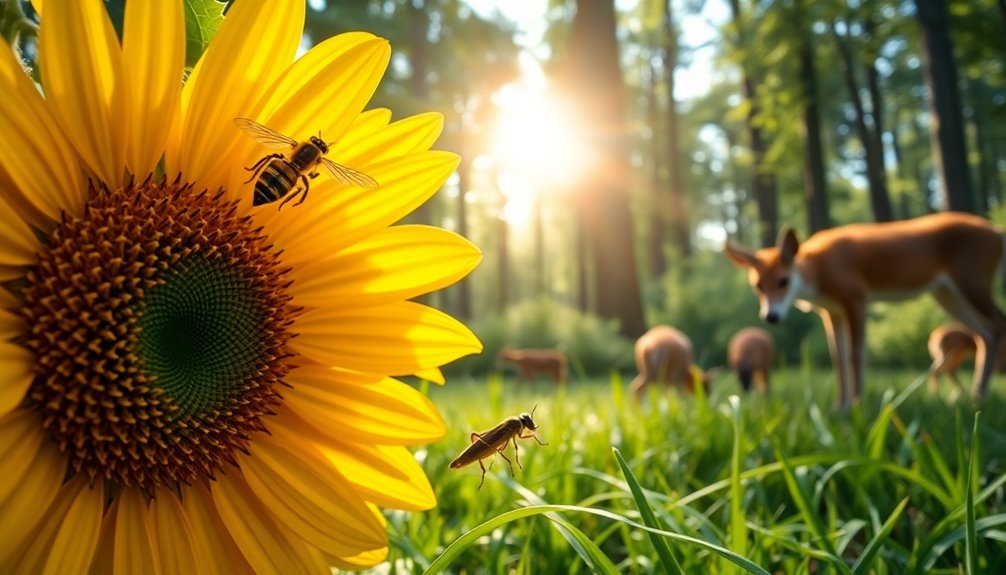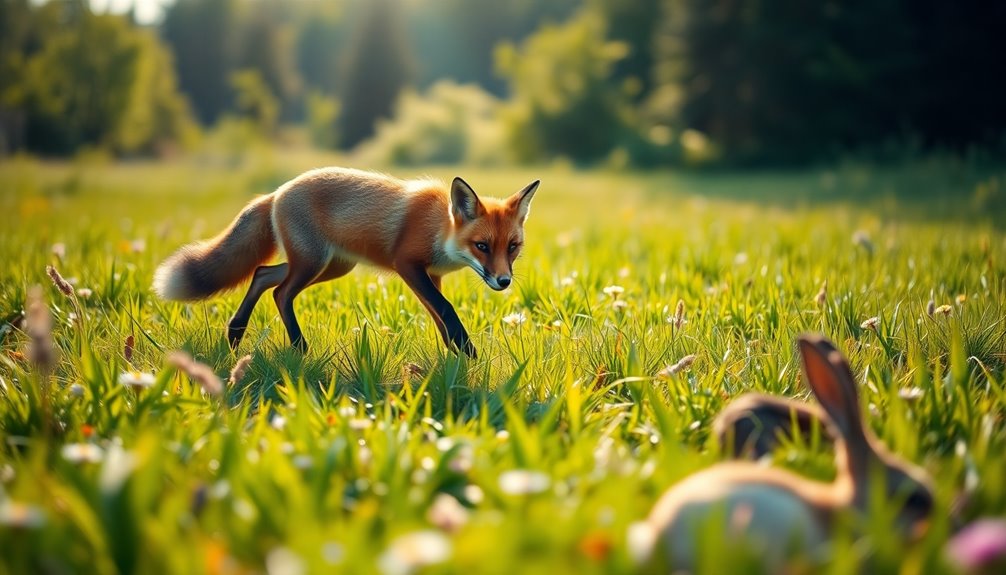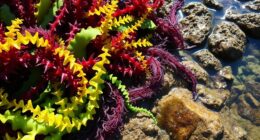Ideal foraging is an impressive strategy animals use to survive by maximizing their energy intake. By acting rationally, they choose food sources that provide the best energy return while considering time and risk. Different feeding systems, like predators and grazers, exhibit unique foraging behaviors based on their energy needs. Factors like prey density and environmental conditions further influence how animals forage. This fascinating model, rooted in the Ideal Diet Model and Marginal Value Theorem, reveals how wildlife adapts to challenges in their habitats. There's so much more to uncover about these survival strategies and their implications for animals everywhere.
Key Takeaways
- Optimal Foraging Theory explains how animals maximize energy intake while foraging for food in diverse environments.
- Animals assess energy gained against handling and travel time to optimize their feeding strategies.
- Different foraging strategies, like predation and grazing, illustrate how species adapt to their nutritional needs.
- The Marginal Value Theorem helps predict when animals should leave a resource patch to maximize energy intake.
- Empirical studies reveal that real-world foraging behavior often deviates from theoretical predictions due to environmental factors and social dynamics.
Understanding Optimal Foraging Theory

Ideal Foraging Theory (OFT) offers a fascinating lens through which you can understand how animals make foraging decisions. At its core, ideal foraging theory posits that animals aim to maximize their net energy intake by balancing the energy acquired from food with the energy spent searching for and handling it.
This balance is essential because foraging behavior is influenced by several factors, including energy gain per unit time and travel time.
The Ideal Diet Model highlights how foragers prioritize more profitable prey, ignoring less beneficial options to enhance their foraging efficiency.
When faced with limited resources, animals often assess their prey choice based on the energy provided versus the time it takes to capture and consume it.
The Marginal Value Theorem further refines this understanding, suggesting that foragers should leave a food patch once the energy gain falls below the average for the environment.
Key Components of Foraging Models

When you think about foraging models, two key components stand out: currency and constraints.
Currency represents what the animal aims to optimize, like energy or nutrients, while constraints are the limiting factors that impact their foraging efficiency.
Understanding these elements is essential for grasping how animals adapt their foraging strategies in different environments.
Currency Definition and Importance
In ideal foraging models, understanding the concept of currency is vital for grasping how animals make foraging decisions. Currency represents the specific unit that animals aim to maximize, such as net energy gain per unit time or nutrient acquisition efficiency. This concept directly influences their foraging strategies.
When you identify an appropriate currency, you can better predict foraging behavior, since it dictates how animals prioritize prey selection based on energy content and handling time.
Different animals define their currency differently. For instance, a predator might focus on energy gain, while a herbivore may prioritize nutrient quality or the ratio of energy intake to foraging time. Understanding these distinctions is significant, as they shape the foraging strategy each species employs.
Moreover, constraints such as environmental factors or physiological limitations can affect how effectively an animal maximizes its currency. By recognizing these dynamics, you enhance the predictive power of ideal foraging theory.
This insight allows you to appreciate the trade-offs animals navigate to maximize their fitness in various ecological contexts, showcasing the complexity and adaptability of foraging behavior in the animal kingdom.
Constraints Affecting Foraging Efficiency
Foraging efficiency is shaped by several key constraints that influence an animal's ability to gather food effectively. Understanding these constraints helps you see why certain animals thrive in specific environments while others struggle. Here are some essential factors to take into account:
- Environmental factors: Habitat structure and prey availability can limit access to food resources.
- Physiological limitations: An animal's metabolic rate and digestive capabilities dictate how much energy it can expend and how quickly it can process food.
- Handling time: The time taken to capture and consume prey must be balanced with the energy gained from each item.
Travel time to and from foraging patches plays a significant role in overall energy gain. Longer travel distances reduce the time left for actual foraging, impacting efficiency.
The Marginal Value Theorem illustrates that as animals exploit a patch, energy gain decreases over time, leading them to leave when the costs of continued foraging exceed the benefits.
Types of Feeding Systems

Animals exhibit a fascinating variety of feeding systems, each finely tuned to their ecological niche and energy needs. True predators, like tigers and sharks, enhance their foraging strategies to kill prey quickly. This method maximizes energy intake while minimizing injury risks.
In contrast, grazers, such as antelope and mosquitoes, consume food without killing it, requiring unique foraging strategies that balance energy intake with foraging time costs.
Parasites, like tapeworms, have adapted to live on or within hosts, extracting nutrients while expending minimal energy. Meanwhile, parasitoids, such as certain wasps, present a unique strategy by laying eggs inside hosts, effectively combining predation and parasitism.
Generalist predators, like raccoons, benefit from diverse diets, allowing them to adapt to various food availabilities. On the other hand, specialists, such as koalas, focus on specific prey types, which can affect their foraging efficiency based on resource abundance.
Each of these feeding systems reflects distinct foraging behaviors and ideal decision rules, ensuring that animals efficiently meet their energy needs in a dynamic environment.
The Optimal Diet Model

When you're out foraging, evaluating prey profitability is essential.
You need to take into account both the energy gain and the time it takes to handle each type of prey to make the best choices.
Prey Profitability Assessment
In the quest for ideal energy intake, the Optimal Diet Model provides a framework for evaluating prey profitability. This model helps you understand how animals decide what to eat based on energy gain and handling time. By calculating the energy gain (E) from a prey item divided by its handling time (h), you can see why foragers prioritize high E/h ratios.
- Foragers often ignore low-profitability prey when better options are available.
- Search time (S) varies with prey abundance, influencing foraging efficiency. In addition, animals may also rely on hydration levels to maintain optimal function during their foraging activities. Proper toilet design features can significantly enhance comfort and functionality, much like how optimal foraging strategies enhance survival. Just as puppies benefit from puppy training classes, animals learn to adapt their foraging techniques to maximize efficiency. Furthermore, understanding survivalism principles can provide insights into the broader implications of resource management in nature.
- Generalists balance handling time and energy gain, while specialists target specific, profitable prey.
This assessment of prey profitability plays a vital role in foraging behavior. When food is abundant, animals can afford to be picky, focusing on the most advantageous prey. Conversely, in scarcity, they may adapt their strategies.
Empirical studies on birds and mammals consistently show that these creatures align their foraging behavior with the Optimal Diet Model, often avoiding less profitable prey. By understanding these dynamics, you gain insight into the intricate strategies animals use to maximize their energy intake in the wild. Additionally, just as animals assess prey profitability, businesses must evaluate their options to ensure optimal decision-making for sustainability.
Energy Gain Considerations
Understanding energy gain is essential for evaluating prey selection through the Ideal Diet Model. This model calculates the energy gain per unit from prey items relative to handling time, providing a profitability ratio (E/h) that guides your foraging decisions. According to ideal foraging theory, you'll often ignore less profitable prey when more energy-rich options are available, maximizing your net energy intake over time. Additionally, just as heat pumps optimize energy usage based on demand, foraging decisions can be adapted to maximize efficiency in energy gain.
As you pursue specific prey types, be aware of the law of diminishing returns. The energy gained decreases relative to the time invested, which can prompt you to switch prey types when necessary. Additionally, having a growth mindset allows you to adapt your strategies as conditions change and new opportunities arise. Moreover, understanding the impact of temporary hearing loss can help you recognize how environmental factors might affect your ability to forage effectively.
Generalists typically have varied diets, often opting for prey with shorter handling times. In contrast, specialists focus on high-value prey that may demand more time and effort to capture and process. Factors such as ambient temperature can affect prey availability, influencing your foraging strategies.
Your foraging strategies will also be influenced by factors like prey abundance and environmental conditions. Adjusting your prey selection based on the availability and profitability of different prey types can considerably enhance your survival. Additionally, understanding the concept of risk tolerance can help you make better decisions about which prey to pursue in uncertain environments.
Handling Time Evaluation
Evaluating handling time is a critical aspect of the Best Diet Model, directly influencing your foraging decisions. By considering the energy gained from a prey item and the time needed to handle it, you can calculate the profitability ratio (E/h). This ratio helps you identify which prey to pursue for maximum foraging efficiency.
- Low profitability prey can be ignored when better options are available.
- Handling time can vary greatly due to prey defenses, impacting your energy efficiency.
- Adjusting your foraging strategies based on the abundance of prey enhances your overall success.
When you encounter prey with high defenses, you'll find that increased handling times can lead to lower foraging efficiency. The Ideal Diet Model suggests that under varying ecological conditions, you should adapt your strategies to enhance your diet.
For example, if abundant, highly profitable prey are present, you'll focus on them rather than wasting time on less profitable options. Empirical studies show that many foragers, like birds and mammals, often align their behaviors with these predictions.
Functional Responses in Foraging

Predators' foraging strategies are intricately linked to the concept of functional responses, which illustrate how prey density impacts the rate at which predators capture their food. Functional response curves categorize these relationships into three types: Type I, Type II, and Type III.
In a Type I response, the rate of prey capture increases linearly with prey density, meaning predators can efficiently capture food without being restricted by handling time.
However, in a Type II response, as prey density rises, the rate of prey capture starts to decline due to increased handling time. This creates a saturation point where additional prey doesn't markedly enhance the capture rate.
On the other hand, the Type III response reveals a low capture rate at low prey densities, which sharply increases as prey becomes more abundant. This often occurs because predators adapt and switch to more effective hunting strategies.
Understanding these functional responses is essential, as they greatly influence predator-prey interactions and population dynamics. By grasping how these responses work, you can better appreciate the delicate balance within ecosystems and the strategies animals employ to survive.
Marginal Value Theorem Explained

Efficiency in foraging is vital for survival, and the Marginal Value Theorem (MVT) offers a strategic framework for understanding how animals enhance their resource use. According to MVT, as you spend more time in a resource patch, the energy gain per unit time decreases due to increased search time for prey. This reflects the law of diminishing returns, making it important to determine the ideal time to stay in a patch.
Here are some key aspects of the Marginal Value Theorem:
- It predicts when foragers should leave a resource patch.
- It maximizes net energy intake by balancing energy gain and foraging duration.
- Empirical studies validate the adjustments in patch-leaving decisions based on resource quality.
In essence, MVT helps you gauge when it's best to move on to another patch, ensuring you're not wasting time where energy gain has diminished.
This foraging strategy is universal, applicable to various species, including humans, demonstrating that enhancing resource use is essential across different ecological contexts. By understanding MVT, you can appreciate how animals make informed decisions to improve their survival.
Examples From the Animal Kingdom

Animals frequently demonstrate remarkable foraging strategies that highlight the principles of Ideal Foraging Theory (OFT) in action. For instance, the European Bee-eater maximizes energy intake by selecting prey based on energy content and handling time, while lions target weaker antelope to conserve energy and increase their hunting success. Additionally, many animals rely on nutritional value to inform their foraging decisions, ensuring they obtain the best possible energy return from their efforts.
Here are some compelling examples of best foraging strategies:
| Animal | Foraging Strategy | Key Focus |
|---|---|---|
| European Bee-eater | Chooses prey with high energy content and low handling time | Maximum energy efficiency |
| Lions | Hunt weaker or younger antelope to conserve energy | Increased hunting success |
| Raccoons | Adaptable diet, consuming fruits, insects, and small animals | Flexible foraging approach |
| Red Squirrels | Leave food patches when energy gained is less than energy expended | Marginal value theorem |
| Pied Wagtails | Prefer medium-sized prey for best energy gain-to-handling time | Smart prey selection |
These examples illustrate how various animals employ best foraging strategies to maximize energy efficiency, ensuring their survival in diverse environments. By understanding these behaviors, you gain insight into the fascinating world of animal foraging. Additionally, just as animals adapt their foraging tactics, humans can also learn from traditional practices, such as the traditional tea ceremony, which emphasizes mindfulness and respect in the preparation of tea.
Critiques and Limitations of OFT

Critics often point out that Ideal Foraging Theory (OFT) has significant limitations that can affect its applicability to real-world scenarios. While OFT offers a framework for understanding animal behaviors, it often falls short in capturing the complexities of nature.
- OFT may neglect the role of reproductive fitness.
- It may oversimplify the impact of environmental variability on foraging strategies.
- The reliance on energy maximization could ignore other vital factors like risk avoidance and competition.
Many researchers argue that OFT models inadequately test for reproductive fitness, raising questions about their completeness. Additionally, the theory's theoretical assumptions can oversimplify complex animal behaviors, failing to take into account social dynamics and the nuances of environmental variability.
Discrepancies between predicted and actual behaviors suggest that the currencies and constraints identified mightn't always be accurate, highlighting the need for more empirical validation.
Although OFT maintains theoretical consistency, this doesn't always translate into practical application. Researchers sometimes adapt models to fit observed data, complicating rigorous hypothesis testing.
Fundamentally, while OFT provides valuable insights, it's important to acknowledge its limitations and the factors that shape foraging decisions in the wild.
Frequently Asked Questions
What Is the Optimal Foraging Theory of Animals?
The ideal foraging theory suggests that animals forage in ways that maximize their energy intake while minimizing the energy they expend.
You can think of it like a balancing act; animals weigh the benefits of food against the costs of finding it.
This theory explains why some animals are generalists, eating a variety of foods, while others are specialists, focusing on high-profit prey that meets their energy needs efficiently.
What Is the Foraging Strategy of Animals?
Animals use various foraging strategies to find food efficiently.
You might notice some species are generalists, eating a wide range of prey to guarantee they get enough energy, while others are specialists, focusing on high-return items.
By observing their surroundings, they adjust their behavior based on what's available.
When searching for food, they also consider travel time and energy costs, assuring they maximize their gains while minimizing effort.
What Is the Optimality Theory of Foraging?
Imagine you're a chef in a bustling kitchen, deciding which dish to prepare for maximum tips in the shortest time.
The Efficiency Theory of Foraging works similarly; it's all about making smart choices. You weigh the energy you'll gain from food against the effort to obtain it.
What Does the Optimal Foraging Theory Predict That the Behavior of an Animal Will?
The ideal foraging theory predicts that you'll see animals choosing prey that offers the highest energy return for the least effort.
They'll often ignore less profitable options, focusing instead on energy-rich prey. You might notice them adjusting their foraging behavior based on food availability and competition, leaving a food patch when their energy intake slows down.
This strategy helps maximize their energy gain and enhances their chances of survival and reproduction.
Conclusion
In the dance of survival, ideal foraging shines as a guiding star, illuminating the path animals tread in search of sustenance. By mastering the art of efficient food gathering, they weave a tapestry of life that balances energy and nutrition. While critiques of this theory linger like shadows, its insights into nature's intricate strategies empower you to appreciate the delicate choreography of life around you. Embrace the wonder of these savvy foragers, and let their wisdom inspire your own quests.










